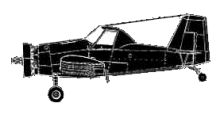
ASN Wikibase Occurrence # 235215
This information is added by users of ASN. Neither ASN nor the Flight Safety Foundation are responsible for the completeness or correctness of this information.
If you feel this information is incomplete or incorrect, you can submit corrected information.
| Date: | Thursday 24 August 2017 |
| Time: | 10:00 |
| Type: |  Air Tractor AT-401 |
| Owner/operator: | Fitch's Flying Service |
| Registration: | N4532F |
| MSN: | 401-0769 |
| Year of manufacture: | 1990 |
| Total airframe hrs: | 6228 hours |
| Engine model: | Pratt & Whitney R-1340AN-1 |
| Fatalities: | Fatalities: 0 / Occupants: 1 |
| Aircraft damage: | Substantial |
| Category: | Accident |
| Location: | Pearsall, TX -
 United States of America United States of America
|
| Phase: | Manoeuvring (airshow, firefighting, ag.ops.) |
| Nature: | Agricultural |
| Departure airport: | Pearsall, TX (T30) |
| Pearsall, TX (T30) | |
| Investigating agency: | NTSB |
| Confidence Rating: |
The commercial pilot was conducting a local, agricultural application flight when the engine experienced a partial loss of power during a spray pass. The pilot's corrective actions did not restore normal engine operation, and he conducted a forced landing to a nearby field. The airplane descended into tall vegetation and landed in soft, sandy soil and then decelerated rapidly and nosed over.
Postaccident engine examination revealed a circumferential fracture of the No. 9 cylinder. Further examination determined that the cylinder fractured from a fatigue crack that had initiated at multiple locations at a valley between two cooling fins on the outside surface. The fatigue crack progressed inward and circumferentially around the cylinder before finally cracking in overstress. No discrepancies, such as corrosion pits, wear marks, or machining marks, were found at the crack initiation sites. The cylinder met the airplane manufacturer's material and hardness specifications. The fracture would have allowed combustion gasses to escape during engine operation and led to a corresponding loss of cylinder compression, which would have led to erratic engine operation and a partial loss of power. According to engine logbook documentation, no cylinder cracks were found during an airworthiness directive inspection completed about 64 flight hours before the accident.
Probable Cause: The fatigue crack of an engine cylinder, which resulted in a partial loss of engine power.
Accident investigation:
 |
|
Sources:
NTSB
Location
Revision history:
| Date/time | Contributor | Updates |
|---|---|---|
| 19-Apr-2020 07:04 | ASN Update Bot | Added |
Corrections or additions? ... Edit this accident description
The Aviation Safety Network is an exclusive service provided by:


 ©2024 Flight Safety Foundation
©2024 Flight Safety Foundation